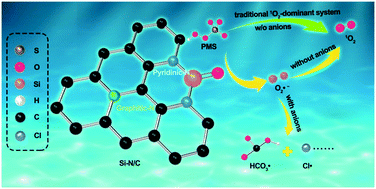A unique Si-doped carbon nanocatalyst for peroxymonosulfate (PMS) activation: insights into the singlet oxygen generation mechanism and the abnormal salt effect†
Abstract
The heteroatom-doped, carbon-activated peroxymonosulfate (PMS) system proceeding via the non-radical oxidation pathway involving singlet oxygen (1O2) represents a promising advanced oxidation process (AOP) due to the resistance of 1O2 to background anions in solution. However, the performance level of pollutant removal is not yet satisfied, and the mechanism of 1O2 generation remains elusive. Herein, we report the development for the first time of a unique Si-engaged heteroatom (i.e., N)-doped carbon (Si/N–C) nanomaterial for PMS activation, which exhibits outstanding performance in the removal of various kinds of pollutants and an appreciably wide working pH range of 2.5 to 11. Taking rhodamine B (RhB) as an example, the Si/N–C@PMS system achieved a much higher reaction rate (0.64 min−1) than the Si–C (0.047 min−1), N–C (0.017 min−1), SiO2 (0.021 min−1), and Co3O4 (0.026 min−1; a standard catalyst) systems. In addition, the results of electron spin resonance (ESR) and scavenging experiments solidly support the conclusion that the mechanism of 1O2 generation in this system is via the recombination of superoxide radicals O2˙−, a pathway seldom reported for metal-free, catalyst-activated PMS systems. More importantly, we observed apparent inhibition effects of the anions (e.g., HCO3−, HPO42−, and PO43−) on the degradation performance, inconsistent with many previous reports suggesting that the 1O2-mediated oxidative system possesses a high selectivity toward pollutant degradation in the presence of these anions. Further studies with the anions, including Cl−, HCO3−, and HxPO4(3−x) (x = 0, 1, 2), suggest that the reaction between O2˙− and these anions is the main reason for the abnormal salt effect. This work will deepen the understanding of 1O2 formation via the intermediate of O2˙− and provide a new insight into its salt resistance capacity.



 Please wait while we load your content...
Please wait while we load your content...